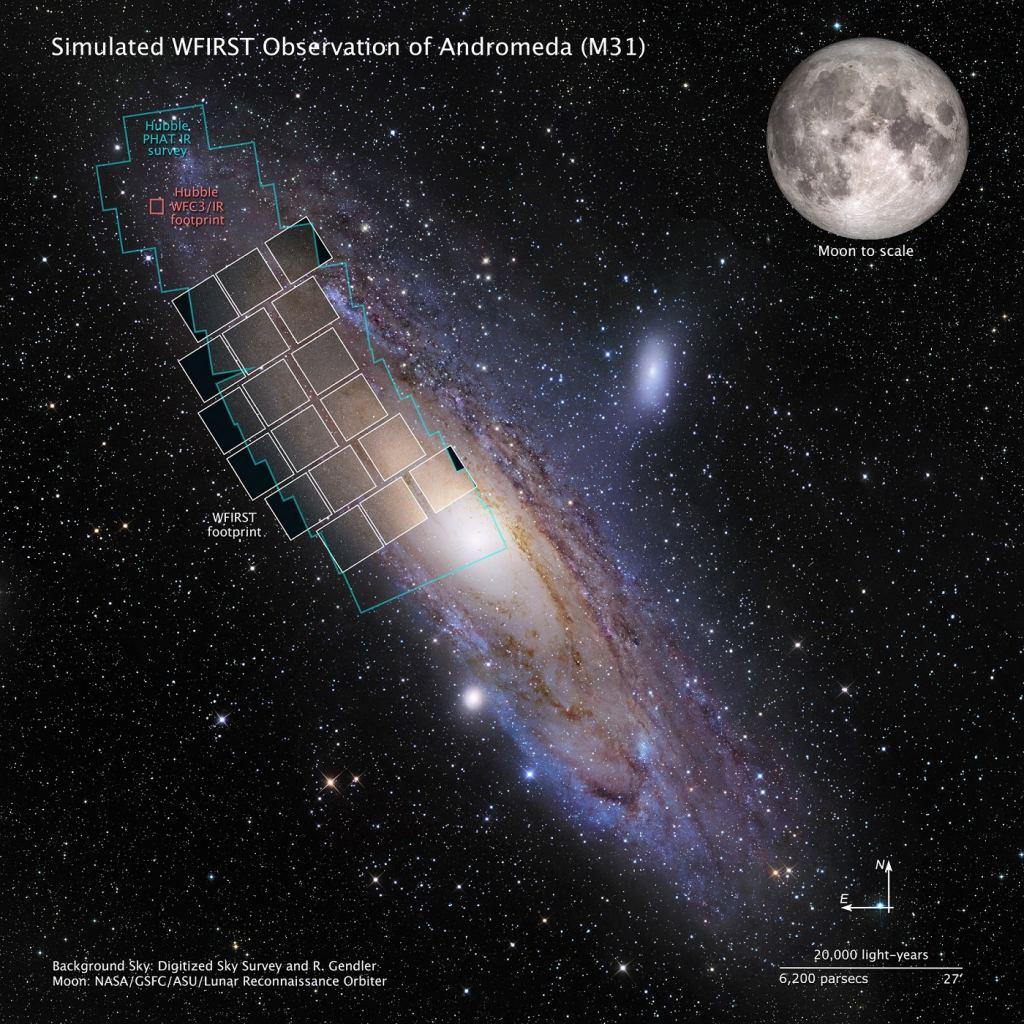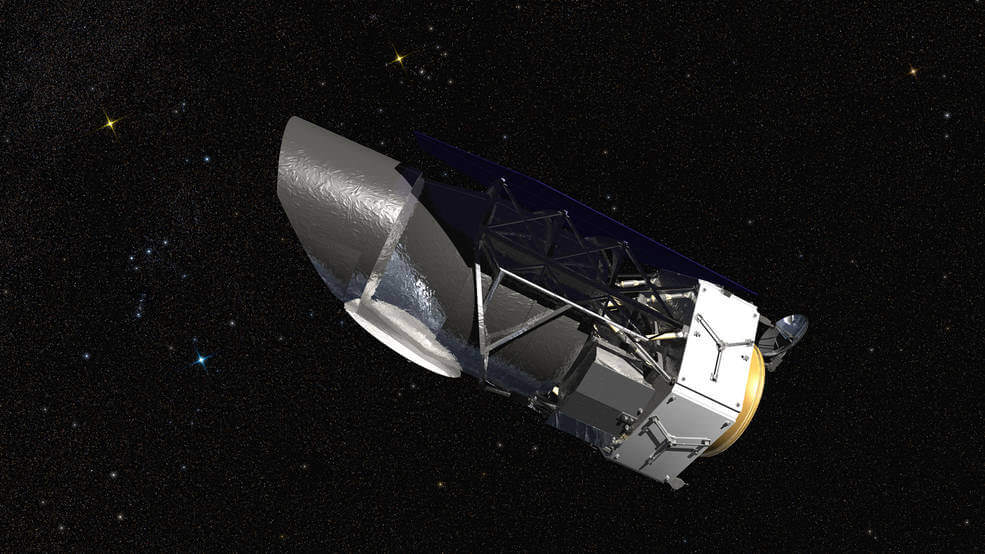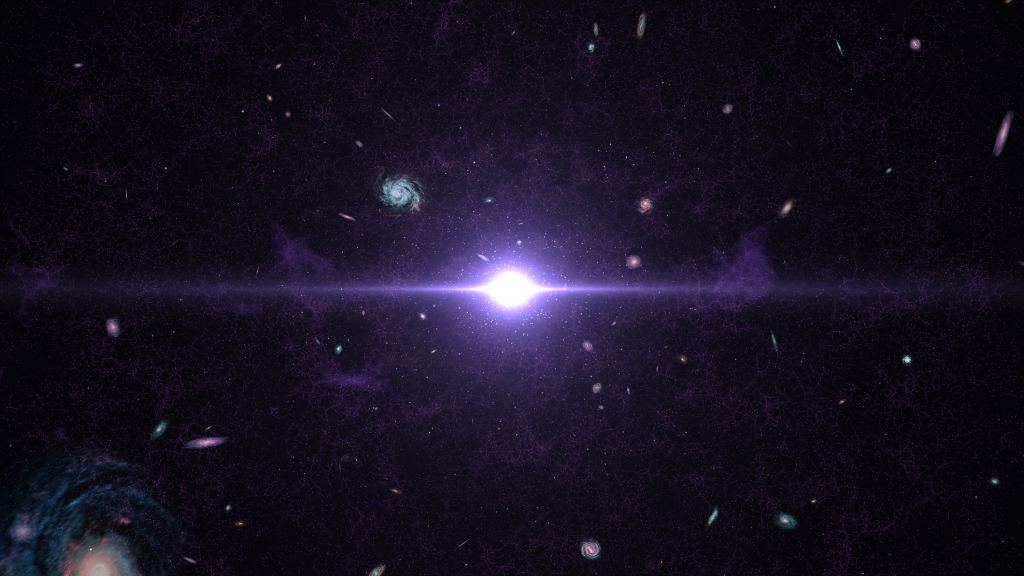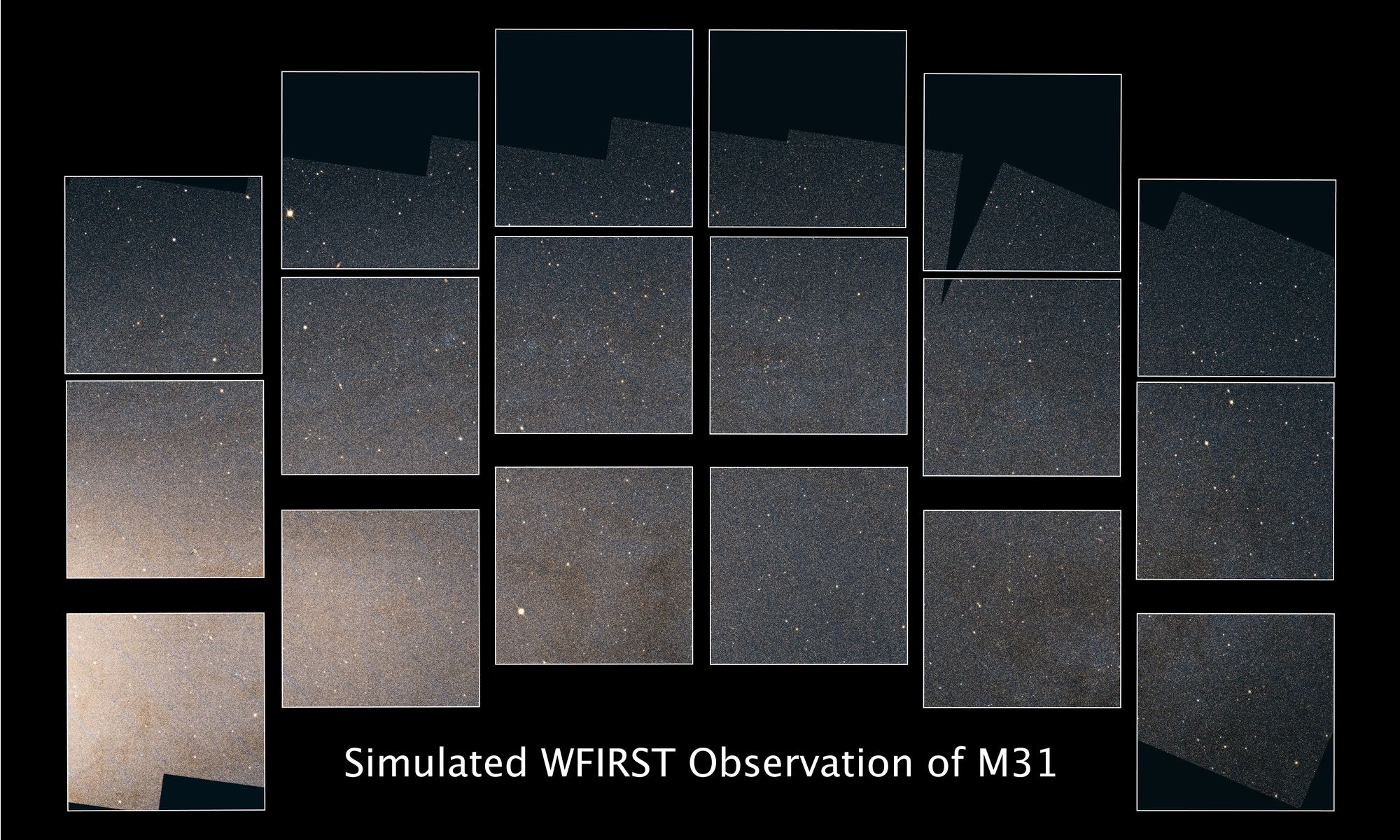When it takes to space in 2025, the Wide-Field Infrared Survey Telescope (WFIRST) will be the most powerful observatory ever deployed, succeeding the venerable Hubble and Spitzer space telescopes. Relying on a unique combination of high resolution with a wide field of view, WFIRST will be able to capture the equivalent of 100 Hubble-quality images with a single shot and survey the night sky with 1,000 times the speed.
In preparation for this momentous event, astronomers at NASA’s Goddard Space Flight Center have been running simulations to demonstrate what the WFIRST will be able to see so they can plan their observations. To give viewers a preview of what this would look like, NASA’s Goddard Space Flight Center has shared a video that simulates the WFIRST conducting a survey of the neighboring Andromeda Galaxy (M31).
The simulation, which was presented this week at the 235th meeting of the American Astronomical Society (ASS) in Honululu, relies on data obtained by Hubble over the course of hundreds of observations of Andromeda. This way, the simulation gives viewers a preview of the vast expanse and fine detail that the WFIRST can provide with just a single image.
The simulated shot covers a region of space measuring 34,000 light-years across and showcases the red and infrared light of over 50 million individual stars. With this kind of imaging power, the WFIRST could survey in a few months as much of the sky in the near-infrared spectrum as Hubble did over the course of three decades – and in just as much detail.
Elisa Quintana, the WFIRST Deputy Project Scientist for Communications at NASA’s Goddard Space Flight Center, is confident the WFIRST will lead to a revolution in astrophysics. As she stated in a recent NASA press release:
“To answer fundamental questions like: How common are planets like those in our solar system? How do galaxies form, evolve, and interact? Exactly how – and why – has the universe’s expansion rate changed over time? We need a tool that can give us both a broad and detailed view of the sky. WFIRST will be that tool.”
The 18 images shown in the simulation represent an accurate portrayal of what the WFIRST will see with every pointing and image shot. With its 18 detectors, each of which measures 4096 x 4096 pixels, the WFIRST will cover an area roughly 1.33 times that of a Full Moon with every pointing – whereas individual Hubble images cover an area less than 1% the area of a Full Moon.
In addition to its imaging capabilities, there’s also the extraordinary survey speed that the WFIRST will offer, which is the result of its wide field of view. By being able to monitor a greater area in a single pointing and switch from one field to another quickly, the mission team will not have to go through the laborious process of being repointed every time they want to survey a new field.

Another factor is the orbit that the WFIRST will occupy, which will give a view of space that is generally unobstructed by Earth. Whereas Hubble‘s Low Earth Orbit (LEO) of about 560 km (350 mi) meant that it was often able to collect data for only half of its orbital period, WFIRST will be in a wide orbit of about 1.6 million km (1 million mi). At this distance, it will be able to conduct observations in an almost continuous fashion.
Ben Williams, an astronomer at the University of Washington in Seattle, was responsible for generating the simulated data set for this image. As he explained, the WFIRST will provide a valuable opportunity to understand large nearby objects like Andromeda, which are otherwise extremely time-consuming to image because they take up such a large portion of the sky:
“We have spent the last couple of decades getting images at high resolution in small parts of nearby galaxies. With Hubble you get these really tantalizing glimpses of very complex nearby systems. With WFIRST, all of a sudden you can cover the whole thing without spending lots of time.”
Basically, the ability to capture images of such a large area will provide astronomers with the context they need to understand how stars form and how galaxies change over time. Essentially, a wide field of view will allow astronomers to not only study individual stars or galaxies but also the structures they inhabit and the surrounding environment.

With this level of technology and capability at their disposal, mission controllers look forward to collecting massive amounts of data on the cosmos. Over the course of its 5-year planned mission, WFIRST is expected to amass more than 20 petabytes of information on thousands of planets, billions of stars, and millions of galaxies. This data will be used to address the fundamental questions of the cosmos and the laws governing it.
These include whether cosmic expansion is due to a mysterious, unseen force (aka. Dark Energy) or a breakdown of General Relativity on cosmological scales; when the first galaxies appeared in the Universe and how they have since evolved; and whether or not planets beyond our Solar System (extrasolar planets) have sufficient atmospheres and the necessary conditions on their surfaces to support life.
Julianne Dalcanton, a professor of astronomy at the University of Washington, led the Panchromatic Hubble Andromeda Treasury (PHAT) program that the simulated data are based on. As she explained, the combination of WFIRST’s ultra-telephoto and super-wide-angle capabilities (as demonstrated with their simulation) have the potential to be ground-breaking:
“The PHAT survey of Andromeda was a tremendous investment of time, requiring careful justification and forethought. This new simulation shows how easy an equivalent observation could be for WFIRST.”

Once it’s operational, WFIRST will spend a significant portion of its time monitoring hundreds of thousands of distant galaxies for supernova explosions, which can be used to study Dark Energy and the expansion of the Universe. It will also use this time to map the shapes and distributions of galaxies in order to better understand how the Universe has evolved in the nearly 14 billion years since the Big Bang.
WFIRST will also monitor the brightness of billions of stars in the Milky Way to be on the lookout for possible microlensing events. These occur when planets pass between their star and the observer, temporarily amplifying the star’s light. Giving its high-resolution, WFIRST is expected to detect many exoplanets that are small, distant from their star, and rogue planets – thus playing a vital role in completing the census of exoplanets.
WFIRST will also carry act as a technology demonstrator by carrying a coronagraph, an instrument designed to block out the light of a star so that planets orbiting it can be directly imaging and characterized. In another first, the data collected by WFIRST will be open-access and immediately available to the public. According to Dalcanton, this is one of the most important aspects of the mission.
“Thousands of minds from across the globe are going to be able to think about that data and come up with new ways to use it,” she said. “It’s hard to anticipate what the WFIRST data will unlock, but I do know that the more people we have looking at it, the greater the pace of discovery.”

To top it all off, the WFIRST mission will complement observatories that are already in space. These include NASA’s Hubble and the James Webb Space Telescope (which will also be conducting extensive surveys in the near-infrared), as well as the ESA’s Euclid mission – which will be measuring the rate at which the Universe is expanding to determine the role played by Dark Matter and Dark Energy.
As Karoline Gilbert, a WFIRST Mission Scientist at the Space Telescope Science Institute (STSI) in Baltimore, Maryland, put it:
“With one hundred times the field of view of Hubble, and the ability to rapidly survey the sky, WFIRST will be an extremely powerful discovery tool. Webb, which is 100 times more sensitive and can see deeper into the infrared, will be able to observe the rare astronomical objects discovered by WFIRST in exquisite detail. Meanwhile, Hubble will continue to provide a unique view into the optical and ultraviolet light emitted by the objects that WFIRST discovers, and Webb follows up on.”
The 2020s are shaping up to be a very exciting time for astronomers and space exploration enthusiasts. Aside from next-generation ground and space telescopes that will be entering service, a number of missions are destined to go to the Moon, to Mars, and the outer Solar System. If the mysteries of the Universe and all that lies within it can be likened to an onion, then several layers are sure to be peeled back in this decade!
The simulated image is being presented at the 235th meeting of the American Astronomical Society in Honolulu, Hawaii.
Further Reading: NASA Hubblesite

